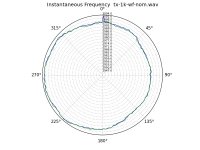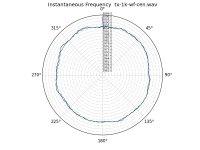Remember my calculation for motor revolutions in 1.8 seconds? If the file was made on a 50Hz turntable and a 16 pole motor, exactly 1/4 cycle offset per revolution is expected
The files are indeed cutouts of a longer recording to meet the forums upload restrictions for attachments.
The motor is probably a 4-phase 8 pole servo as stated at Yamaha GT-2000 on thevintageknob.org (I found vintageknob.org not always acurate, however.)
I'm on 50Hz and use a step-down-transformer to match the voltage requirements.
R.
The motor is probably a 4-phase 8 pole servo as stated at Yamaha GT-2000 on thevintageknob.org (I found vintageknob.org not always acurate, however.)
I'm on 50Hz and use a step-down-transformer to match the voltage requirements.
R.
Last edited:
However, this case is totally different: the test files intentionally induce headshell motion at determined LF frequencies, inducing FM in the carrier, and this clearly happens for all of the six test files at different frequencies as intended. In this case, nothing to do with motor cogging in any of the test files ...........Remember my calculation for motor revolutions in 1.8 seconds? If the file was made on a 50Hz turntable and a 16 pole motor, exactly 1/4 cycle offset per revolution is expected
On another occasion, when motor cogging is at issue, you would be right - except that phase slip wouldn't typically be progressive around a rotation, unless something is very seriously slipping...........
LD
Cogging with 11.25 cycles per revolution would be progressive and if you could display five revolutions, you should see the fifth pattern on top of the first.
However, that is not what we see here at all. Rather, a continuous progressive phase slip within one rotation..........Cogging with 11.25 cycles per revolution would be progressive and if you could display five revolutions, you should see the fifth pattern on top of the first.
.......frequency being rate of change of phase and all.........
Besides, posts crossed and Onvinyl confirms the test files are cutouts from a longer test track. That makes sense. If it looks like a duck and quacks..............🙄
LD
Does anyone have one of the current Chinese sourced DD decks? It will be interesting to see how they compare with the old Japanese designs
Except.........that isn't the case.This has been interesting reading, has anyone noticed that two very different design drive decks the Technics and Lenco. Who have the reputation of being the BEST sounding decks in the world, also measure the best. (suppose that should be no surprise!!) Cheers
IME having spent a few years at examining dozens of 3rd party test sample files, is that many TTs have some fault or another which isn't there by design. Technics DDs tend to consistently be up there partly because they don't often exhibit gross faults. However, many respectable TTs can show comparable or better rotational stability in the absence of faults, which are unfortunately common.
Lencos almost always have some residual motor shaft pitch variation IME, which is like a signature, and that might be euphonic but means they typically don't measure well. Certainly not 'best' by any means.
And pretty much any super-pitch-stable TT can be mucked up by an unstable cart/arm combination. The effect of which typically dominates when all faults are eliminated, and sometimes is as bad as other faults.
Finally, the effect of record centring and vertical run-out, including warp, is profound and usually swamps all other effects in respectable rigs.
So, addressing record centring, platter vertical run-out and record warp, and cart/arm stability, is where the vast bulk of pitch stability action is. In this sense, most TTs are pretty equal as to pitch stability, but it's usually worth fixing those faults.
LD
Last edited:
I tried the locked runout groove speed check last night. I was easy to find an LP by ear that seemed to be a sharp distinct click.
It was easy by eye to find its position to better than one sample period at 96K, more than enough resolution. Problem, if you look at our plots of continuous speed there are "bumps" that repeat every revolution, this technique only samples a single spot. This would be true of the scratched groove technique too.
Still in many cases this give a good indication of relative speed within the accuracy of the clocks in your DAC. I got 33.375 RPM and 33.373 RPM 30 sec later.
It was easy by eye to find its position to better than one sample period at 96K, more than enough resolution. Problem, if you look at our plots of continuous speed there are "bumps" that repeat every revolution, this technique only samples a single spot. This would be true of the scratched groove technique too.
Still in many cases this give a good indication of relative speed within the accuracy of the clocks in your DAC. I got 33.375 RPM and 33.373 RPM 30 sec later.
Attachments
Yes, but that misses the point that variation in pitch is far more significant to audibility than absolute pitch......... reasonably, so long as there's no gross-out....Still in many cases this give a good indication of relative speed within the accuracy of the clocks in your DAC. I got 33.375 RPM and 33.373 RPM 30 sec later.
LD
Yes, but that misses the point that
Simply an attempt to double check the frequency calibration.
OK I get it thanks: checking absolute frequency of the recorded carrier tone on the test record.Simply an attempt to double check the frequency calibration.
LD
I thought it was just to measure how long it takes for the LP to make a full turn. At a 96kHz sampling rate, the measurement is very fine.
Yes that is true but there should be 1800 cycles of a 1kHz tone in 1.8 seconds at 33 1/3 RPM. So it is a double check on the frequency accuracy of the recorded tone on the LP. This information could be used to scale your results to as good as the clock on your DAC is.
I agree. It worth the effort.
If you enjoyed the photo, see here for the real story.
Lenco Motor Capacitor
😱
George
Ah yes. That's a bit delayed at the moment. The bits are there, just the time. At least all the bulbs are in the garden ready for spring so I should get a bit more time (where a bit is tempered by what the kids will let me get up to)...
- Home
- Source & Line
- Analogue Source
- Turntable speed stabilty
 Test LP posts moved to new thread
Test LP posts moved to new thread

